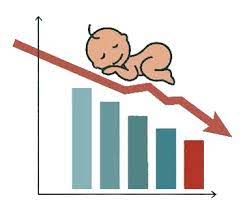Low Fertility Rate in Jammu and Kashmir: A Cause for Concern
By: Javid Amin
Srinagar, February 8, 2025 – The fertility rate in Jammu and Kashmir (J&K) has been steadily declining over the years, raising concerns about the region’s demographic future. According to the National Family Health Survey (NFHS-5), the Total Fertility Rate (TFR) in J&K is 1.4, significantly lower than the national average of 2.0 and well below the replacement level of 2.1. This trend suggests that the region’s population is shrinking rather than maintaining a stable growth rate, which could lead to serious socio-economic challenges in the coming decades.
Understanding the Decline
The TFR represents the average number of children a woman is expected to have during her reproductive years. A TFR below the replacement level indicates that the population is not replenishing itself from one generation to the next, leading to long-term demographic challenges such as labor shortages, aging populations, and economic stagnation. In J&K, the decline in fertility rates can be attributed to several interrelated factors:
1. Increased Education and Economic Independence
As literacy rates and higher education levels among women improve, their participation in the workforce increases. Educated women often prioritize career growth, financial stability, and personal development, leading to a delay in marriage and childbearing. This shift has had a significant impact on fertility rates, as women who marry later typically have fewer children.
2. Widespread Availability of Contraceptives
The accessibility and awareness of modern contraceptive methods allow couples to plan their families more effectively. With increased family planning education and health services, many couples opt for smaller families, leading to a natural decline in fertility rates.
3. Changing Social Norms and Lifestyle Preferences
There has been a noticeable shift in societal attitudes toward marriage and parenthood. Younger generations are increasingly prioritizing personal aspirations, financial security, and work-life balance over traditional family structures. The growing cost of raising children, including expenses related to education, healthcare, and housing, also discourages larger families.
4. Delayed Marriages and Late Childbearing
In recent years, there has been a clear trend toward late marriages in J&K. With women marrying later, their reproductive window shortens, reducing the likelihood of having multiple children. Fertility naturally declines with age, and the medical risks associated with late pregnancies also deter women from having larger families.
5. Economic Uncertainty and Job Market Constraints
Limited economic opportunities, particularly for men, contribute to delayed marriages and smaller families. Job security plays a crucial role in family planning decisions, and many couples in J&K hesitate to expand their families due to financial instability.
6. Government Policies and Family Planning Initiatives
Government-sponsored awareness campaigns and family planning programs have successfully encouraged responsible parenthood. While these initiatives have positive aspects, they also contribute to reduced fertility rates by promoting contraceptive use and smaller family norms.
Regional Variations in Fertility Rates
While the overall fertility rate in J&K is low, there are regional disparities. According to NFHS-5 data, Ganderbal district recorded the lowest TFR at 1.1, while Kishtwar reported the highest at 2.0. Other districts displayed varying fertility rates, including:
- Kathua: 1.2
- Poonch: 1.8
- Ramban: 1.8
- Pulwama: 1.3
- Reasi: 1.3
- Shopian: 1.3
- Doda: 1.4
- Rajouri: 1.4
- Srinagar: 1.4
- Udhampur: 1.4
- Bandipora: 1.5
- Kupwara: 1.5
- Kulgam: 1.5
- Baramulla: 1.6
- Anantnag: 1.7
- Budgam: 1.7
- Jammu: 1.2
- Samba: 1.4
The variation in fertility rates across different districts indicates the influence of economic, educational, and cultural factors on family planning choices.
Potential Measures to Address Declining Fertility Rates
Addressing the issue of low fertility rates requires a comprehensive approach that balances economic stability, social well-being, and family support systems. Here are some potential strategies:
1. Financial and Economic Incentives
- Direct financial support to families for each child born.
- Tax deductions or credits for parents with children.
- Subsidized housing or down payment assistance for families.
2. Improved Childcare and Family Support Services
- Increased availability of affordable daycare and preschool services.
- More generous parental leave policies for both mothers and fathers.
- Flexible work arrangements to support work-life balance.
3. Policies Supporting Women’s Career and Family Balance
- Encouraging workplace policies that accommodate working mothers, such as on-site childcare and flexible hours.
- Career advancement programs for women who balance professional and family responsibilities.
4. Cultural and Social Awareness Campaigns
- Promoting the benefits of larger families through media campaigns.
- Addressing societal perceptions that discourage parenthood.
- Engaging religious and community leaders to advocate for family growth.
5. Healthcare and Fertility Support
- Increased access to fertility treatments and support for couples facing reproductive challenges.
- Better maternal healthcare facilities and prenatal care support.
The Future of Jammu and Kashmir’s Demographics
While declining fertility rates in J&K pose demographic challenges, the region must adopt balanced policies that support sustainable population growth without imposing pressures on resources and the environment. Any intervention should respect personal choices and promote gender equality, ensuring that women are empowered to make informed decisions about marriage and childbearing.
The need for a multifaceted approach cannot be overstated. By addressing the economic, social, and cultural factors contributing to declining fertility rates, J&K can secure a more stable and prosperous future for its residents. Ensuring a supportive ecosystem for families will be key to reversing the downward trend and maintaining a vibrant population that contributes to the region’s growth and development.
Bottom-Line
The declining fertility rate in J&K is a pressing issue that requires immediate attention. While multiple factors contribute to this trend, solutions must be holistic and inclusive. By fostering economic stability, enhancing family-friendly policies, and addressing cultural shifts, J&K can create an environment where families thrive, and population stability is maintained. As the region moves forward, proactive measures and strategic planning will be essential in shaping its demographic and economic future.




